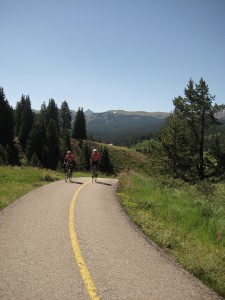
Ste. Anne church in Detroit
One resource that makes biking in Detroit so unique and spectacular is its historic churches.
Ste. Anne de Detroit
Did you know that the second oldest continuously open Catholic parish in North America is in Corktown? St. Anne was founded by Cadillac in 1701, the same year as the City of Detroit. The parish is now in their 8th church, which was opened in 1887.
Father Gabriel Richard is called the Second Founder of Detroit and is the church’s more famous pastor. He rallied Detroiters to rebuild the City after the Great Fire of 1805. In fact he gave the City its motto: Speramus Meliora; Resurget Cineribus (“We Hope For Better Things; It Shall Rise From the Ashes”.)
Richard was a founder of the University of Michigan, MIchigan’s delegate to Congress when it was just a territory, and lobbied for the completion of Michigan Avenue from Detroit to Chicago.
Richard’s remains are kept in a chapel at the church.

Gabriel Richard's remains at Ste. Anne
Sweetest Heart of Mary
This is beautiful church just north of Eastern Market and situated midway between the St. Albertus and St. Josaphat churches. All three Catholic churches served the Polish communties on Detroit’s east side.
Below is an excert from Olivier Zunz’ book, “The Changing Face of Inequality:”
The building of Sweetest Heart of Mary and the controversy that surrounded it provides a perfect example of the Poles’ difficulties with the hierarchy and of their dedication to their churches. It also sheds light on internal dissensions within the Polish community, between those willing to abide by the bishop’s authority, and those (priests and parishioners alike) preferring a uniquely Polish American church which would leave some decisions to the laity. In 1886, Bishop Borgess dismissed Father Kolasiñski from his pastorate at Saint Albertus when, amidst other charges of disobedience, he refused to submit his financial books to the bishop for audit. His popularity among his parishioners, however, was such that many of Saint Albertus’s congregants violently protested their pastor’s dismissal. A crowd of women initially forbade entrance to the church to the new pastor, Father D the founder of the Polish seminary, and this was only one in a series of violent incidents which divided the Polish community over the degree of autonomy of the Polish-American church. Kolasiñski’s supporters went as far as severing their ties from the diocese and waited for Kolasiñski’s return to Detroit in December 1888 to build a new church of their own, Sweetest Heart of Mary, without the bishop’s consent, just a few blocks away from Saint Albertus.

Sweetest Heart of Mary on Russell at Canfield
In retaliation, the bishop excommunicated all Kolasiñski’s parishioners, and the new church was not dedicated until December 1893, when the dispute was finally resolved and Kolasiñski publicly reconciled with the hierarchy.
In the meantime, a group of Poles managed to break away from the Catholic hierarchy to keep their priest on the job; they bought the land for a new church for $13,600, and built church, school, and presbytery for another $13,700. A few years later, the parishioners started a fund-raising drive for a new church building, and in 1897, Sweetest Heart of Mary was estimated to be the most expensive church building of the Polish community. That year, however, the community defaulted on its debt. American Savings Bank refused to extend the repayment period and took the case to court. The community tried to settle the dispute by paying the interest of the debt or $7,700; Potrzuski, a butcher on Riopelle, alone gave $2,800. This sum, however, did not settle the dispute; the case was tried and the church sold at a public auction for $30,000, to a lawyer, Mr. McGravie. The Polish community took the case to a higher court, charging that a property appraised at $214,000 could not be sold for $30,000. The court granted a new auction, but in the meantime community leaders managed to get a new loan for $65,000 from London Bank in Montreal, which many community members guaranteed by mortgaging their homes, and bought off the church from McGravie. This dramatic story of a church built by excommunicated parishioners against the orders of church hierarchy, so expensive that the community defaulted, and yet a church that the parishioners managed to buy a second time with money secured by new mortgages on their homes, clearly demonstrates the communal strength of Detroit’s Polonia.









